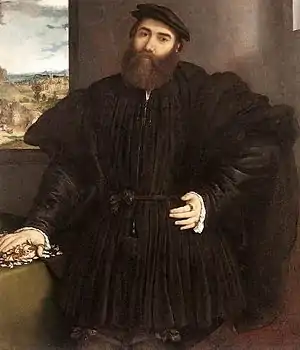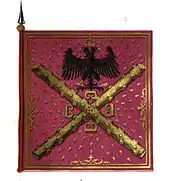Mercurio Bua
Mercurio Bua (Albanian: Mërkur Bua; Greek: Μερκούριος Μπούας, romanized: Merkourios Bouas) Count of Aquino and Roccasecca (1478 in Nafplion – c.1542 in Treviso) was a famed condottiero (stratioti captain) and commander of the Venetian army. In some sources he was referred to as Buia.[2][3][4][5][6]
Mercurio Bua | |
|---|---|
 Portrait of a Gentleman, thought to be Mercurio Bua by Lorenzo Lotto[1] | |
| Other name(s) | Mercurio Buia |
| Born | 1478 Nafplion |
| Died | c.1542 Treviso |
| Rank | condottiero (stratioti captain) |
Life

Born in Nafplion in the Peloponnese, Mercurio was the son of Peter Bua (fl. 1450s), who belonged to the Albanian noble family of Bua that settled in Peloponnese, and who was the leader of the Albanian community of the region after the fall of the Despotate of the Morea.[8][9] His uncle Constantine Arianiti, a nobleman of the Holy Roman Empire, was the Count of Montferrat.[10] Due to his martial prowess, he was eventually made Count of Aquino and Roccasecca (of the Holy Roman Empire). In 1519, he married Maria Boccali, the daughter of Niccolò Boccali.[10] Maria died in 1524 leaving one son with the name Flavio. She was buried in Santa Maria di Treviso. In 1525 Mercurio married Elisabetta, daughter of Alvise Balbi. With her Mercurio had four children: Helena Maria, Curio, Polyxena and Alessandro. Elizabeth died in or before 1528.[11]
The life of Bua had been dramatised in the works of Tzanes Koronaios. Koronaios, who had been stradiotti-troubadour of Zantiote origin, was a companion of Merkourios Bouas. In his work, a long epic poem in vernacular Greek on the exploits of Merkourios Bouas, Koronaios gives Bua's mythological pedigree, which includes Achilles, Alexander the Great and Pyrrhus.[12] This poem was found in a manuscript in Italy and was published partially by C. Hopf and entire by K. Sathas. It was written in 1519 when Coroneos was in Venice and refers to Bua's history till 1517. It consists of about 4.500 rhyming verses and contains valuable historical information. Coroneos wrote and sent to Bua also a smaller poem (“pittakion”) of about 125 verses in Greek language, too.[13][14]
Another mention of a Mercurio Bua exists in the Histoire des guerres civiles de France by Enrico Caterino Davila. There a man named Mercurio Bua was active in the service of the king of France in the 1580s. He was present as a commander of a unit of light cavallery at the Battle of Coutras in 1587, leading an ill-fated cavallery charge that led to his unit being diverted away from the decisive action, thus contributing to a catastrophic defeat of the royal army.[15] Nevertheless, it is unknown if it is the same person.
M. Bua died in Treviso, (Italy), between 1527 and 1562, where earlier he served as captain of a unit of 50 soldiers. He is buried in Santa Maria Maggiore in the same city. In 1562 a marble monument was erected on his tomb, made by Antonio Lombardo. In 1637 the following inscription was made on the monument:
"Mercurio Bua Comiti E. Principibus Peloponnesi
Epirotarum Equitum Ductori,
Anno Salu. MDCXXXVII."
Which means "To Count Mercurio Bua, Prince of Peloponnesus, Leader of the Epirote Horsemen, Year of our Salvation, 1637". The monument also lists some of his military career.[16][17]
See also
- Thomas of Argos, another prominent stradioti of the Bua family.
Sources
Citations
- Fossi, Gloria; Bussagli, Marco; Reiche, Mattia (2000). Italian art: painting, sculpture, architecture from the origins to the present day. Giunti Editore Firenze Italy. pp. 182–3. ISBN 88-09-01771-4.
- Institutul de Istorie și Arheologie "A.D. Xenopol." (1987). Anuarul Institutului de Istorie și Arheologie "A.D. Xenopol.". Editura Academiei Republicii Socialiste România. p. 91.
Intre acestia, un loc insemnat 1-a ocupat Mercurio Buia, ajuns la inceputul secolului XVI in serviciul imparatului Maximilian de Habsburg, care l-a primit in rindul contilor imperiului. ... Familiei Buia (Bua)...
- Magazin istoric. 1994. p. 62.
Mercurio Buia („Bua" — socotit „albanez") a dobândit în serviciul împăratului Maximilian de Habsburg
- Valente, Francesca (28 September 2014). "San Girolamo Emiliani sarà patrono di Quero Vas". Corriere delle Alpi. Retrieved 1 June 2020.
Girolamo Miani capitò a Quero quasi per caso all'inizio del 1511, per sostituire il fratello Luca nel ruolo di governatore della fortezza di Castelnuovo (siamo negli anni della guerra della Lega di Cambrai contro la Repubblica di Venezia). Il 27 agosto dello stesso anno il forte fu raggiunto da 3 mila fanti francesi inviati da Jacques de La Palice (proprio l'ispiratore dell'aggettivo “lapalissiano”) che guidati dal capitano di ventura Mercurio Buia conquistarono la fortezza, uccidendo tutti i soldati nemici, tranne Girolamo e due capitani bellunesi.
- (Bujduveanu 1997, p. 91):"1495 = Familia Buia a dat din acest an până la finele secolului al XVI-lea opt căpitani de armatoli. Mercuriu Buia trece în Italia cu vreo..."
- (Giurescu & Giurescu 1976, pp. 395, 405):"Familia Buia a dat de la 1495 pînă la finele secolului al XVI-lea nu mai puţin de opt căpitani, dintre care Mercuriu Buia a avut o deosebită însemnătate....Buia, Mercuriu - capitan"
- K.N., Hellenika Anekdota, Athens, 1867, vol. 1, Original in a manuscript written by Ioannes (Tzanes) Coroneos. It was studied and copied at the library of the King of Italy between 1856-1861 by various Greek researchers and published by K. N. Sathas in 1867.
- Gramaticopolo 2016, p. 47: "Pietro Bua, di nobile famiglia albanese trapiantata nel Peloponneso, considerato dalla comunità albanese della regione come loro capo dopo la caduta del despotato di Morea."
- Floristán 2019, p. 10: "Dalle notizie del 1457, conosciamo i fratelli Alessio e Giovanni Bua uno dei quali fu padre di Pietro Bua, a sua volta padre di Mercurio Bua, famoso condottiero e capitano degli stradioti nei primi decenni del sec. XVI."
- Bassani, Lucia Nadin (2008). Migrazioni e integrazione: il caso degli Albanesi a Venezia (1479-1552). Bulzoni. ISBN 978-88-7870-340-7. Retrieved 22 December 2010.
- Ricciardi Maria Luisa (1989) Lorenzo Lotto, "Il Gentiluome della Galleria Borghese", Artibus et Historiae, vol. 10, No 19, p. 96. Available through JSTOR.)
- Of the various people called Pyrrhus, the most likely candidates would seem to be the mythological Neoptolemus, son of Achilles and king of Epirus, and the historically-documented King Pyrrhus of Epirus.
- Hopf Charles (1873) Ex Jannis Coronei Rebus a Mercurio Bua gestis, in Chroniques Greco-Romanes, Librairie de Weidmann, Berlin, pp 367- 370. (Contains the first 136 verses).
- Sathas K., chapter A, pp 1-153.
- Davila, Enrico Caterino (1657). Histoire des guerres civiles de France. 1. Paris. p. 563.
- Sathas K. (1867), Andragathemata of Bua, by Tzanes Coroneos, Hellenika Anekdota, vol.1, p.123, in Greek language
- Edward Hutton: Venice and Venetia. Read Books, 2009. Page 229. ISBN 1-4446-4992-2.
Bibliography
- Floristán, José M. (2019). "Stradioti albanesi al servizio degli Asburgo di Spagna (I): le famiglie albanesi Bua, Crescia e Renesi". Shêjzat – Pleiades (1–2).
- Gramaticopolo, Andrea (2016). Stradioti: alba, fortuna e tramonto dei mercenari greco-albanesi al servizio della Serenissima (in Italian). Soldiershop Publishing. ISBN 9788893270489.
- Bujduveanu, Tănase (1997). Romanitatea balcanică si civilizația aromânilor. Editura Cartea Aromână. ISBN 978-973-97740-3-1.CS1 maint: ref=harv (link)
- Giurescu, Constantin C.; Giurescu, Dinu C. (1976). Istoria Românilor: De la mijlocul secolului al XIV-lea pînă la începutul secolului al XVII lea. Editura științifică.CS1 maint: ref=harv (link)
